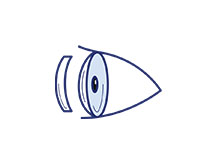
Corneal transplantation, also known as corneal grafting or keratoplasty, is a surgical procedure involving the replacement of a damaged or diseased cornea with a healthy donor cornea. The cornea is the transparent front part of the eye that plays a crucial role in focusing light onto the retina. Corneal transplantation is often performed to restore vision and relieve pain or other symptoms associated with corneal disorders. Here are key points about corneal transplantation:
Indications for Corneal Transplantation:
- Corneal Scarring: Scarred corneas from injuries or infections.
- Keratoconus: A progressive thinning and bulging of the cornea.
- Corneal Dystrophies: Inherited disorders affecting the cornea.
- Corneal Degeneration: Conditions causing the cornea to thin or become irregular.
Types of Corneal Transplantation:
- Penetrating Keratoplasty (PKP): Replacement of the entire cornea with a donor cornea.
- Deep Anterior Lamellar Keratoplasty (DALK): Replacement of the front layers of the cornea, preserving the innermost layer (endothelium).
- Endothelial Keratoplasty (EK): Replacement of the endothelial layer of the cornea, including Descemet's membrane and a thin layer of stroma. Types include Descemet's Stripping Endothelial Keratoplasty (DSEK) and Descemet's Membrane Endothelial Keratoplasty (DMEK).
Donor Corneas:
- Donor corneas are obtained from eye banks and are rigorously screened for quality and infectious diseases.
- The corneas are preserved in a special solution until transplantation.
Surgical Procedure:
- The surgeon removes the damaged or diseased cornea and replaces it with the donor cornea.
- Sutures are used to secure the donor cornea in place.
Recovery and Rehabilitation:
- Recovery time varies depending on the type of keratoplasty.
- Patients may experience temporary visual blurring, and a gradual improvement in vision occurs as the eye heals.
- Eye drops and medications are prescribed to prevent infection and support healing.
Postoperative Care:
- Regular follow-up visits are essential to monitor the healing process and address any complications.
- Vision may continue to improve over several months.
Risks and Complications:
- Risks include infection, rejection of the donor cornea, and astigmatism.
- Close monitoring and prompt intervention can help manage complications.
Visual Rehabilitation:
- In some cases, glasses or contact lenses may be needed for optimal vision after transplantation.
- Visual rehabilitation may include vision therapy.
Corneal transplantation has a high success rate, and many patients experience significant improvements in vision and overall eye health. However, it's important for individuals to understand the potential risks and the need for ongoing postoperative care. If you're interested in this topic, is there something specific you'd like to know or discuss further?